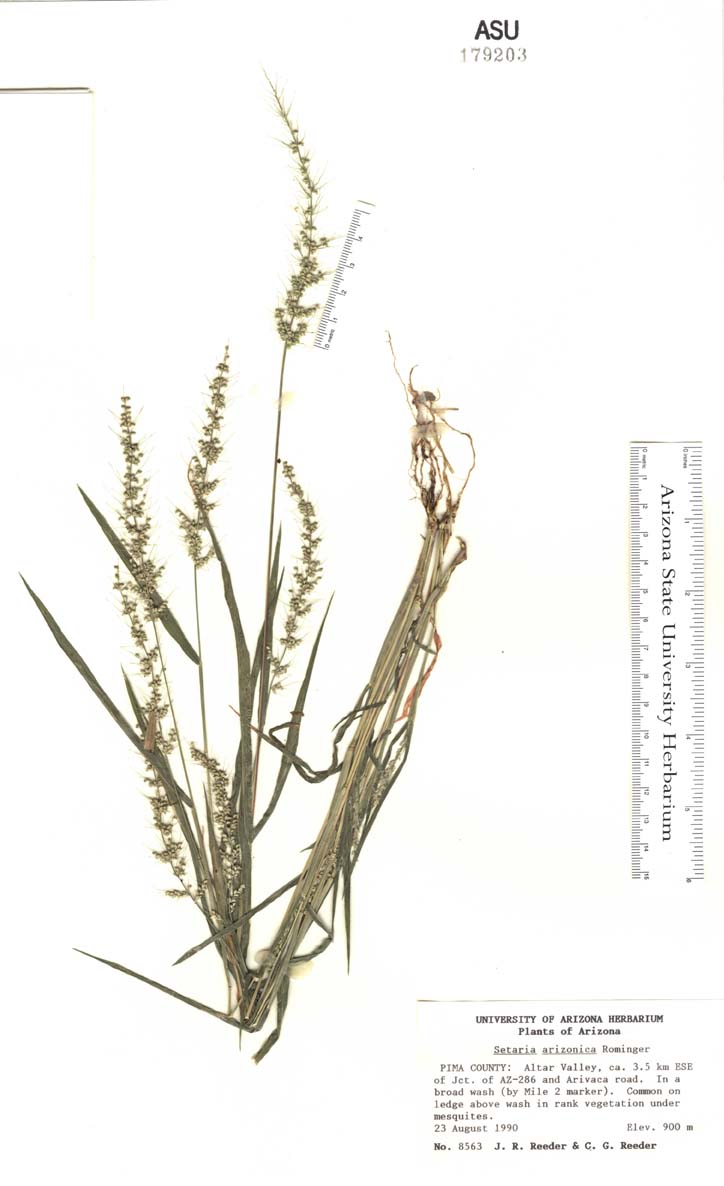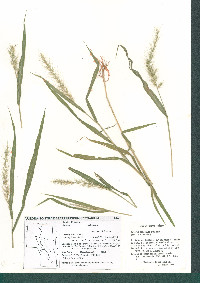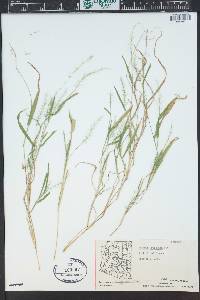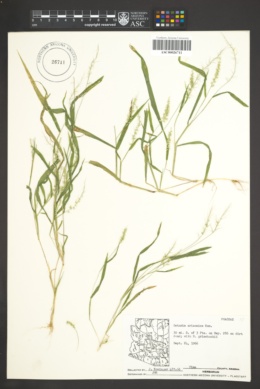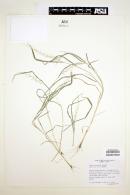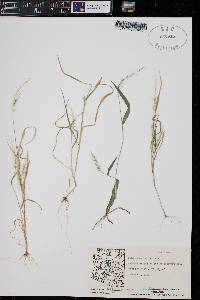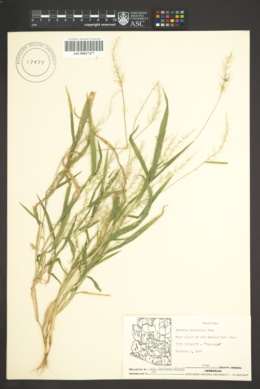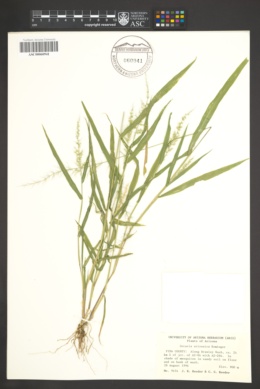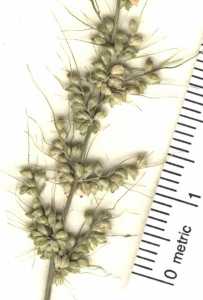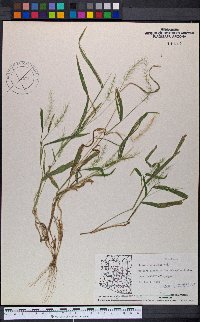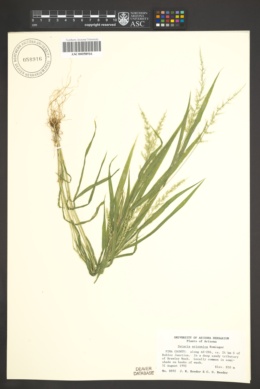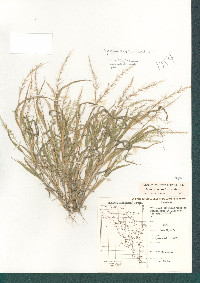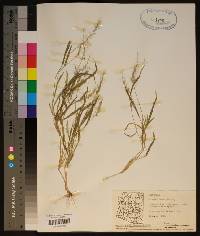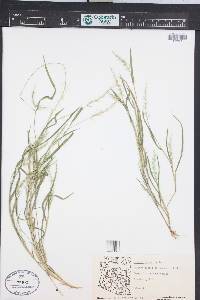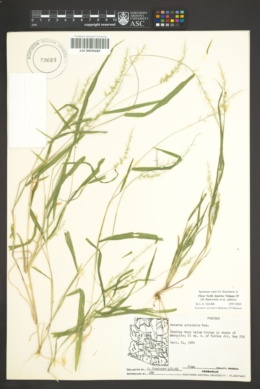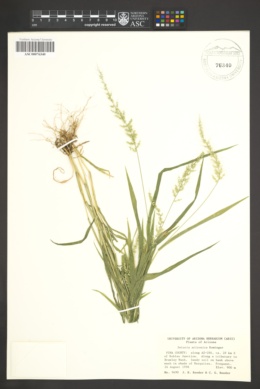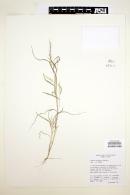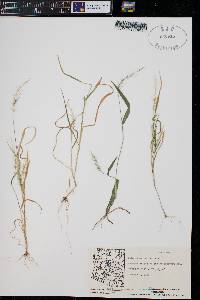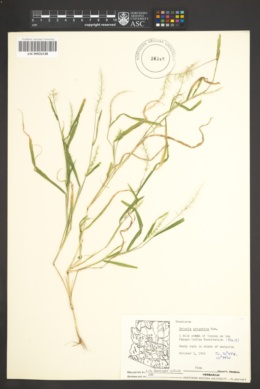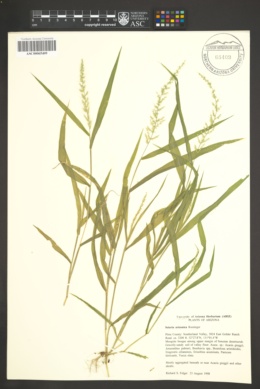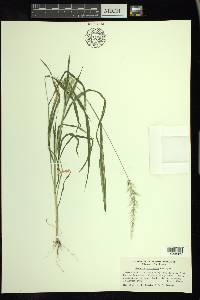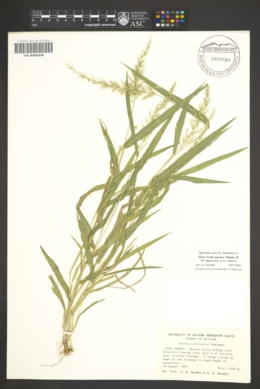Setaria arizonica
|
|
|
|
Family: Poaceae
Arizona Bristle Grass, more...Arizona bristlegrass
|
Plants annual. Culms 25-50 cm; nodes pubescent. Sheaths glabrous, margins ciliate distally; ligules 1-2 mm, ciliate; blades 7-15 cm long, 5-8 mm wide, flat, scabrous, abaxial surface conspicuously hispid over the veins with papillose-based hairs, adaxial surface sparsely hispid over the veins; bristles solitary, 5-15 mm, flexible. Panicles 5-12 cm, loosely spicate; rachises scabrous. Spikelets 1.8-2 mm. Lower glumes about 1/3 as long as the spikelets, 3-veined, lateral veins coalescing with the central vein below the apices; upper glumes about 2/3 as long as the upper lemmas, 5-veined, obtuse; lower paleas equaling the lower lemmas, broad; upper lemmas very strongly and coarsely transversely rugose; upper paleas similar to the upper lemmas. 2n = unknown. Setaria arizonica is locally abundant in sandy washes on both sides of the Arizona-Sonora border, southwest of Tucson. Dr. David Bogler, USDA NRCS PLANTS Database Annuals, Terrestrial, not aquatic, Stems nodes swollen or brittle, Stems erect or ascending, Stems geniculate, decumbent, or lax, sometimes rooting at nodes, Stems caespitose, tufted, or clustered, Stems terete, round in cross section, or polygonal, Stem nodes bearded or hairy, Stem internodes solid or spongy, Stem internodes hollow, Stems with inflorescence less than 1 m tall, Stems, culms, or scapes exceeding basal leaves, Leaves mostly cauline, Leaves conspicuously 2-ranked, distichous, Leaves sheathing at base, Leaf sheath mostly open, or loose, Leaf sheath smooth, glabrous, Leaf sheath and blade differentiated, Leaf blades linear, Leaf blades 2-10 mm wide, Leaf blades mostly flat, Leaf blades mostly glabrous, Leaf blades scabrous, roughened, or wrinkled, Ligule present, Ligule a fringe of hairs, Inflorescence terminal, Inflorescence simple spikes, Inflorescence a dense slender spike-like panicle or raceme, branches contracted, Inflorescence solitary, with 1 spike, fascicle, glomerule, head, or cluster per stem or culm, Inflorescence spike linear or cylindric, several times longer than wide, Inflorescence single raceme, fascicle or spike, Peduncle or rachis scabrous or pubescent, often with long hairs, Flowers bisexual, Spikelets pedicellate, Spikelets dorsally compressed or terete, Spikelet less than 3 mm wide, Spikelets with 1 fertile floret, S pikelets with 2 florets, Spikelet with 1 fertile floret and 1-2 sterile florets, Spikelets solitary at rachis nodes, Spikelets all alike and fertille, Spikelets bisexual, Spikelets disarticulating below the glumes, Spikelets all subtended by bristles, Spikelet bristles 1-3, Spikelet bracts bristles not disarticulating with spikelets, Rachilla or pedicel glabrous, Glumes present, empty bracts, Glumes 2 clearly present, Glumes distinctly unequal, Glumes shorter than adjacent lemma, Glumes 3 nerved, Glumes 4-7 nerved, Lemmas thin, chartaceous, hyaline, cartilaginous, or membranous, Lemma similar in texture to glumes, Lemma becoming indurate, enclosing palea and caryopsis, Lemma 5-7 nerved, Lemma glabrous, Lemma rugose, with cross wrinkles, or roughened, Lemma awnless, Lemma margins thin, lying flat, Lemma saccate or swollen, Lemma straight, Palea present, well developed, Palea shorter than lemma, Palea 2 nerved or 2 keeled, Stamens 3, Styles 2-fid, deeply 2-branched, Stigmas 2, Fruit - caryopsis. FNA 2003 Common Name: Arizona bristlegrass Duration: Annual Nativity: Native Lifeform: Graminoid General: Tufted annual grass, 25-50 cm tall; stems geniculate; nodes pubescent. Vegetative: Sheaths glabrous, the margins ciliate distally; ligules 1-2 mm, ciliate; blades 7-15 cm long, 5-8 mm wide, flat, scabrous, the lower surface conspicuously hispid over the veins with papillose-based hairs, the upper surface sparsely hispid over the veins. Inflorescence: Loosely spicate panicles, 5-12 cm; spikelets 2 mm long and 2-flowered, the lower floret sterile or staminate and the upper floret bisexual; each spikelet subtended by a solitary bristle, 5-15 mm long; lower glumes about 1/3 as long as the spikelets, 3-veined; upper glumes about 2/3 as long as the upper lemmas, 5-veined, obtuse; upper lemmas very strongly and coarsely transversely rugose. Ecology: Found in sandy washes, from 2,000- 4,000 ft (610-1219 m); flowers August-September. Distribution: Pima and Santa Cruz Counties, AZ and neighboring Sonora, MEX, as far south as Navajoa. Notes: Setaria spp. have inflorescences with short, mostly contracted branches and single-seeded, hard spikelets subtended by persistent bristles that remain on the plant after the spikelets have fallen. S arizonica is an annual, locally abundant in sandy washes on both sides of the Arizona-Sonora border, southwest of Tucson. It is distinguished by its loosely paniculate inflorescence, with distinct branching and visible gaps between the branches; this is in comparison to other Setarias which tend to have tighter, spikelike panicles. Note also that each spikelet is subtended by a single bristle. Ethnobotany: Unknown. Synonyms: Panicum appendiculatum, Setaria appendiculata Editor: LCrumbacher2012, AHazelton 2015 Etymology: Setaria comes from the Latin saeta, "a bristle or hair" in reference to the bristly spikelets, while arizonica means of or from Arizona. |

